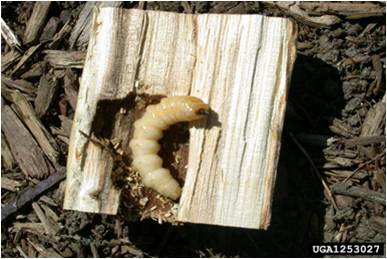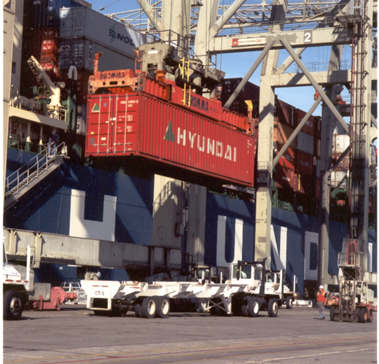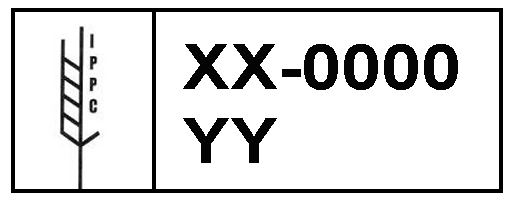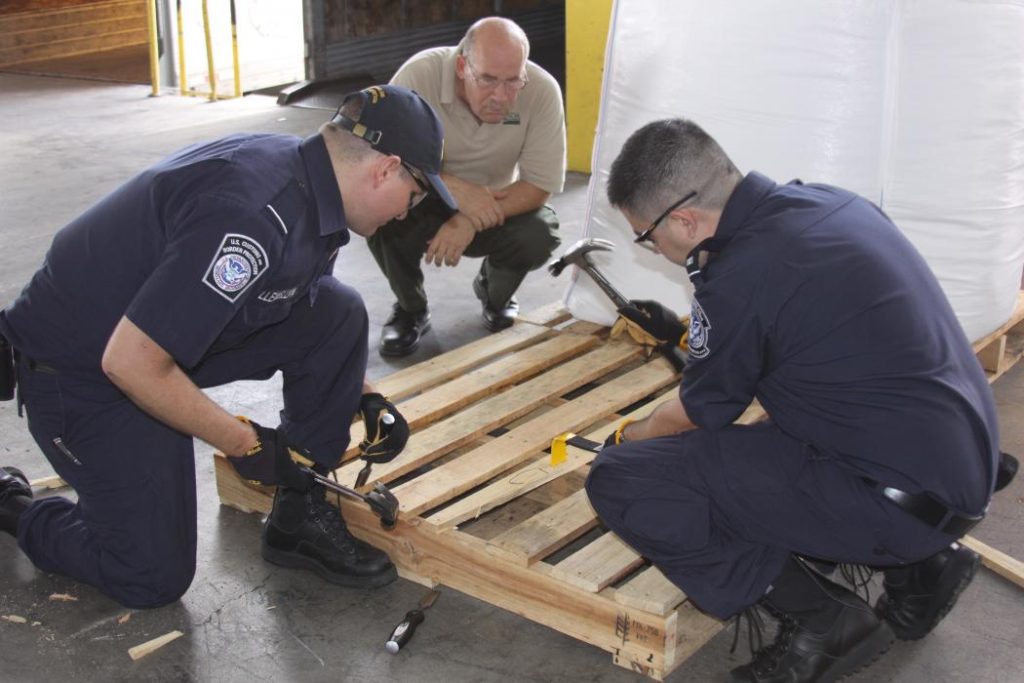
As I noted last November, the premise of the international phytosanitary system – the Agreement on the Application of Sanitary and Phytosanitary Standards (SPS Agreement) and the International Plant Protection Convention (IPPC) – is that importing countries should, and can, rely on exporting countries to take the actions necessary to meet the importing countries’ plant health goals. However, the experience with the International Standard on Phytosanitary Measures (ISPM) #15 and wood packaging casts doubt on this premise.
Exporters are not reliably ensuring the cleanliness of their wood packaging, putting American forests at risk. Indeed, some experts have concluded that continuing to implement ISPM#15 at current levels could triple the number of non-native wood-boring insects introduced into the U.S. by 2050 (Leung et al. 2014).
Too many shipments carry wood packaging that bears no ISPM#15 stamp. And too many pieces of wood packaging arrive with the ISPM#15 stamp, yet are not reliably pest-free. If we cannot clean up this pathway – which involves boards or even logs that are, after all, already dead — it bodes poorly for limiting pests imported with other commodities that are pathways for tree-killing pests – especially living plants (plants for planting). Living plants are much more easily damaged or killed by treatments than the dead wood used in packaging – so ensuring pest-free status of a shipment is even more difficult. (A longer discussion of the SPS Agreement and IPPC is found in Chapter III of Fading Forests II, available here.
Here are the problems – and the latest evidence.

Too Many Shipments with Pest-Infested Wood Packaging Are Reaching the Country
My information on Customs and Border Protection (CBP) interceptions comes primarily from Kevin Harriger (see full reference at end of the blog). I will note when it comes from other sources.
In November 2019, Kevin Harriger reported that over the past three years, CBP detected a regulated pest, on average, in 30% of the wood packaging the agency intercepted because it was not compliant with ISPM#15. Non-compliance is defined as wood packaging that either lacks an official mark or is infested by a quarantine pest, or both.
From this and previous reports, I have 10 years of CBP interception data – from 2020 – 2019. These data thus begin four years after the U.S. began implementing ISPM#15 (in 2006) and 11 years after the U.S. began requiring China to treat wood packaging accompanying its exports (in 1999).
Over the period 2010 – 2018, CBP intercepted an average of 3,183 shipments with non-compliant wood packaging each year. On average, 2,100 (66%) of these shipments lacked the required ISPM#15 mark. A live quarantine pest was found in an average of 794 (25%) shipments. (There was some overlap in the categories).
In 2019, CBP intercepted a total of 2,572 non-compliant shipments (Stephen Brady, CBP, April 2020). Those lacking the ISPM#15 mark number 1,825 (71%). Shipments in which a live pest was found numbered 747 (29%).
The 2019 data show decreases, in absolute numbers, from earlier years in all categories: a 19% decrease below 1010-2018 average of shipments intercepted; a 13% decrease in number of shipments intercepted because the wood packaging lacked the ISPM#15 mark; a decrease of 6% in the number of shipments intercepted that had a quarantine pest. It is too early to say whether CBP’s stronger enforcement approach launched in November 2017 has resulted in a lower number of shipments in violation of ISPM#15 approaching our shores.
There has been a dispute about which categories of packaging are most likely to be infested. The categories are pallets, crates, spools for cable, and dunnage (wood used to brace cargo and prevent it from shifting). The CBP data available to me and the study by Krishnankutty et al. (2020b – see full reference at the end of this blog) shed no light on that issue.
What is the actual number of infested containers approaching our shores? We know that CBP inspects, on average, 2% of incoming containers – so the above interception data reflect a small percentage of probable true approach rate.
The first issue is, how many containers arrive here?

I have been unable to find data for 2019 – much less 2020, when the media report that import volumes have crashed. Until recently, import volumes had been rising. According to a U.S. DOT report to Congress (see reference at the end of this blog), 25 U.S. maritime ports received 24,789,000 loaded shipping containers (measured as TEU – 20-foot equivalent) in 2018. The number of incoming containers had increased at the top three ports – Long Beach, Los Angeles, and New York / New Jersey – between 3% and 7% since 2016.
However, APHIS told me in November 2019 that CBP reports that only about 13 million loaded containers enter the country every year by rail, truck, air, or sea. While I can’t yet explain the discrepancy, one possible explanation is that DoT counts 40-foot containers as two 20-foot containers.
(Of course, pests introduced to Canada also threaten North America’s forests. Canada received fewer than 5 million containers via maritime trade in 2016 (Asbil pers. comm. 2018).
Two decade-old estimates of the proportion of incoming containers that hold wood packaging (Haack et al. 2017, Meissner et al. 2009) allow me to estimate the risk associated with these incoming containers. Meissner et al. found that 75% of maritime containers have wood packaging. Haack et al. estimated that the wood in 0.1% of those containers was infested. Applying these two factors, I conclude that as many as 18,590 of incoming containers in maritime trade could have been transporting a woodborer in the regulated families (Cerambycids, Buprestids, Siricids). I am hesitant to apply the calculation to CBP’s estimate because I don’t know how many of the 13 million containers entered by sea. However, if I assume that the same percentage of wood packaging applied to all the CBP-counted containers, I conclude that 9,750 of those containers held infested wood packaging – still a significant number.
The actual approach rate might be less – or more! Haack et al. (2014) did not include imports from China in their calculations. Given the history of interceptions, it appears probable to me that a recalculation of the approach rate that included China would probably raise the overall proportion.
Furthermore, 11 years have passed since Haack and Meissner made their calculations. During that time, ISPM#15 has been amended to make it more effective. The most important change was restricting the size of bark remnants that may remain on the wood. I have asked several times that APHIS commission a new analysis of Agriculture Quarantine Inspection Monitoring data to determine the pest approach rate before and after the CBP action in order to determine whether the more aggressive enforcement has led to reductions in non-compliant shipments at the border.
By comparing Dr. Haack’s estimate (see above) with the CBP data, I estimate that Customs is detecting and halting the importation of 4 – 8% of the shipments that actually contain pest-infested wood. Since CBP inspects only about two percent of incoming shipments, the higher detection rate demonstrates the value of CBP’s program to target likely violators – and deserves praise. But it is obviously too low a “catch” rate to provide an adequate level of protection for our forests.
ISPS#15 Is Not Helping to Target Inspections

So – ISPM#15 still allows too many pests to arrive at our shores. Is ISPM#15 at least helping phytosanitary agencies target inspections? No, because both U.S. and European data demonstrate that a high proportion of shipments containing infested wood pieces bore the ISPM#15 stamp. Phytosanitary agencies cannot rely on the presence or absence of the stamp to indicate the pest risk level.
U.S. data:
- During the period 2010-2015, CBP found that an average of 95% of pest-infested shipments bore the ISPM#15 mark (Harriger). Unfortunately, CBP data from more recent years don’t provide this breakdown.
- In the past two years, CBP inspectors have repeatedly found pests in dunnage bearing the ISPM#15 mark.
- Krishnankutty et al. (2020b) analyzed wood packaging from 42 countries of origin intercepted by CBP over six years (April 2012 – January 2018). They found that 87% of the interceptions bore the ISPM mark.
I blogged earlier about the velvet longhorned beetle (Trichoferus (=Hesperophanes) campestris) This pest, like others, has reached our shores and entered the country both before and after implementation of ISPM#15. The predictable result is that VLB is established in three states and has been detected in 14 others plus Puerto Rico (Krishnankutty, et al. 2020a). Apparently we have been lucky that this one isn’t as damaging as so many are!
European data:
For Europe, see Eyre et al. (2018). They concluded that the ISPM-15 mark was of little value in predicting whether harmful organisms were present.
This is alarming and we need to understand the reason – How much is caused by fraud? How much is caused by failure of treatment – either intrinsic weakness or incorrect application? APHIS researchers have found that larvae from wood subjected to methyl bromide fumigationwere more likely to survive to adulthood than those intercepted in wood that had been heat treated (Nadel et al. 2016).
Krishnankutty et al. (2020b) query whether the 2009 requirement that wood be debarked might be less effective in countering insect species that require bark only in the early stages of larval development. Half of the species intercepted in hardwood shipments (e.g., Anoplophora glabripennis, Phoracantha recurva) might fit this profile. They also appear to pose a higher threat since they are polyphagous and known to infest healthy hosts. While some of the softwood-inhabiting species also require bark, they not known to infest living trees and only a quarter were classified in the high-risk group. The Mech et al. 2020 finding that no wood-borers that specialize in conifers posed a high risk appears to support these different impacts.
Krishnankutty, et al. (2020b) also note the risk from pallet recycling. The wood might occasionally be infested by dry-wood borers. One puzzling example was wood packaging shipped from Brazil and bearing a Brazilian ISPM#15 stamp that was infested with a larva of T. campestris (VLB). This is an Asian species not recorded as being present in South or Central America. The authors speculate that the pallets were recycled in Brazil after inadequate treatment in their original places of manufacture.
Of the 17 wood borer species intercepted in hardwoods, three have reproducing populations in the U.S.: A. glabripennis, Phoracantha recurva and T. campestris. Krishnankutty et al. (2020b) say that they are unaware of any of the non-native buprestids and siricids intercepted in softwood SWPM being established in the US. (One Siricid that is established, Sirex noctillio, was not detected in the wood packaging analyzed in this study.)
What Can Be Done to Slow or Eliminate this Pathway?

CBP strengthened enforcement of ISPM#15 in November 2017. CBP’s enforcement actions increased by 400% from 2017 to 2018 (John Sagle, CBP, pers. comm). CBP has also expanded its outreach to shippers and others involved in international trade with the goal of reducing all types of non-compliance – lack of documentation, pest presence, etc. in both wood packaging and shipping containers. The outreach includes awareness campaigns targetting trade, industry, affiliated associations, CBP employees, and international partners (Harriger).
Certain countries have a long-standing record of non-compliance with ISPM#15 – as seen in interception records.
- Haack et al. 2014 – Italy was the country of origin for most wood borers intercepted 1985 – 2000.
- Haack et al. 2014 – the top 5 countries in the 2003 – 2009 period were Mexico (33.7%), Italy (14.2%), Canada (13.4%), Netherlands (4.4%), China (4.1%).
- APHIS’ interception database for FY2011-2016 (provided to me) showed Mexico, China, Italy, and Costa Rica had the highest numbers of interceptions.
- Krishnankutty et al. (2020b) found the highest numbers of interceptions came from Mexico, China, and Turkey.
These numbers reflect in part the huge volumes of goods imported from both Mexico and China. But China and Italy stand out for their poor performance. (The U.S. does not regulate – or inspect! – wood packaging from our third-largest trade partner Canada.)
Officials know which individual companies within these countries have a history of non-compliance. For example, 21 of the interceptions on wood packaging made from Populus trees in China (53%) were associated with stone, ceramic, and terracotta commodities. Anoplophora glabripennis was intercepted six times in Populus originating from a single wood-treatment facility in China (Krishnankutty et al. 2020b).
How reduce risk to U.S. forests?
Over the past year or two, I have suggested the following actions:
- USDA APHIS join Bureau of Customs and Border Protection in penalizing violators.
- Citing the need for setting a higher “level of protection”, APHIS & the Canadian Food Inspection Agency (CFIA) should prepare a risk assessment to justify adopting more restrictive regulations. The new regulations should prohibit use of packaging made from solid wood – at least from the countries with records of high levels of non-compliance (listed above).
- USDA Foreign Agriculture Service (FAS) should assist U.S. importers to determine which suppliers reliably provide compliant wood packaging.
- USDA FAS and APHIS should help importers convey their complaints about specific shipments to the exporting countries’ National Plant Protection Organizations (NPPOs; departments of agriculture).
- APHIS should increase pressure on foreign NPPOs and the International Plant Protection Convention more generally to ascertain the reasons ISPM#15 is failing and to fix the problems.
- APHIS should fund more studies and audits of wood packaging to document the current efficacy of the standard, including an urgent update of the Haack study of pest approach rate.
The international standard has demonstrably failed to provide a secure method to evaluate the pest risk associated with wood packaging accompanying any particular shipment. The presence of the stamp on pieces of wood packaging does not reliably show that the wood is pest-free.
The situation is even worse re: movement of plants for planting.
SOURCES
Asbil, W. Canadian Food Inspection Agency, pers. comm. August 2018.
Eyre, D., R. Macarthur, R.A. Haack, Y. Lu, and H. Krehan. 2018. Variation in Inspection Efficacy by Member States of SWPM Entering EU. Journal of Economic Entomology, 111(2), 2018, 707–715)
Haack, R. A., K. O. Britton, E. G. Brockerhoff, J. F. Cavey, L. J. Garrett, M. Kimberley, F. Lowenstein, A. Nuding, L. J. Olson, J. Turner, and K. N. Vasilaky. 2014. Effectiveness of the international phytosanitary standard ISPM no. 15 on reducing wood borer infestation rates in wood packaging material entering the United States. Plos One 9:e96611.
Harriger, K. Executive Director for the Agriculture Programs and Trade Liaison office, Department of Homeland Security Bureau of Customs and Border Protection (CBP), presentations to the Continental Dialogue on Non-Native Forest Insects and Diseases, over appropriate years. https://continentalforestdialogue.org/events/
Krishnankutty, S.M., K. Bigsby, J. Hastings, Y. Takeuchi, Y. Wu, S.W. Lingafelter, H. Nadel, S.W. Myers, and A.M. Ray. 2020a. Predicting Establishment Potential of an Invasive Wood-Boring Beetle, Trichoferus campestris (Coleoptera:) in the United States. Annals of the Entomological Society of America, XX(X), 2020, 1–12
Krishnankutty, S., H. Nadel, A.M. Taylor, M.C. Wiemann, Y. Wu, S.W. Lingafelter, S.W. Myers, and A.M. Ray. 2020b. Identification of Tree Genera Used in the Construction of Solid Wood-Packaging Materials That Arrived at U.S. Ports Infested With Live Wood-Boring Insects. Commodity Treatment and Quarantine Entomology
Leung, B., M.R. Springborn, J.A. Turner, E.G. Brockerhoff. 2014. Pathway-level risk analysis: the net present value of an invasive species policy in the US. The Ecological Society of America. Frontiers of Ecology.org
Mech, A.M., K.A. Thomas, T.D. Marsico, D.A. Herms, C.R. Allen, M.P. Ayres, K.J. K. Gandhi, J. Gurevitch, N.P. Havill, R.A. Hufbauer, A.M. Liebhold, K.F. Raffa, A.N. Schulz, D.R. Uden, & P.C. Tobin. 2019. Evolutionary history predicts high-impact invasions by herbivorous insects. Ecol Evol. 2019 Nov; 9(21): 12216–12230.
Meissner, H., A. Lemay, C. Bertone, K. Schwartzburg, L. Ferguson, L. Newton. 2009. Evaluation of Pathways for Exotic Plant Pest Movement into and within the Greater Caribbean Region. Caribbean Invasive Species Working Group (CISWG) and USDA APHIS Plant Epidemiology and Risk Analysis Laboratory
Nadel, H. S. Meyers, J. Molongoski, Y. Wu, S. Lingafelter, A. Ray, S. Krishnankutty, A. Taylor. 2017. Identification of Port Interceptions in Wood Packing Material Cumulative Progress Report, April 2012 – June 2017
USDA APHIS interception database – pers. comm. January 2017.
USDA APHIS press release dated September 12, 2018
U.S. Department of Agriculture, Press Release No. 0133.20, January 27, 2020
US Department of Transportation. Port Performance Freight Statistics in 2018 Annual Report to Congress 2019 https://rosap.ntl.bts.gov/view/dot/43525
Wu, Y., S.M. Krishnankutty, K.A. Vieira, B. Wang. 2020. Invasion of Trichoferus campestris (Coleoptera: Cerambycidae) into the United States characterized by high levels of genetic diversity and recurrent intros. Biological Invasions Volume 22, pages1309–1323(2020)
Yemshanov, D., F.H. Koch, M. Ducey, K. Koehler. 2012. Trade-associated pathways of alien forest insect entries in Canada. Biol Invasions (2012) 14:797–812
Posted by Faith Campbell
We welcome comments that supplement or correct factual information, suggest new approaches, or promote thoughtful consideration. We post comments that disagree with us — but not those we judge to be not civil or inflammatory.